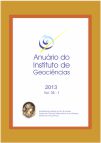Facies Characterization of the Frade Field Reservoirs and Associated Deposits, Campos Basin, Rio de Janeiro State
DOI:
https://doi.org/10.11137/2013_2_45_60Abstract
The Frade Field, located in the northern Campos Basin, corresponds to Oligo-Miocene deep-water reservoirs bracketed between the Azul and Cinza regional markers. Such depositional systems are of great economic significance, representing a large percentage of Brazilian hydrocarbon reserves and production. This paper presents the characterization of the facies that comprise the Frade Field reservoirs and associated deposits. The study included the analysis of 154 m of core from three wells, which are representative of four main field reservoirs. Twelve facies are recognized, of which two are conglomeratic, four are sandy, one is of mixed sand-mud composition and three are heterolithic. The interpretation of these facies indicates a depositional system dominated by the interaction of processes as diverse as debris flows, turbulent flows, bottom currents and slides. The reservoir facies are predominantly bipartite and turbiditic flow sands, whereas the non reservoir facies include mass-transport aprons and cemented debris flow rhodolithic conglomerates, both being very common in the described sequences. Overestimation of hydrocarbon volumes may occur should such facies be inadequately represented. However, when present as interbedded units within the reservoir facies, they generally do not have enough lateral continuity to significantly impair hydraulic connectivity of the reservoir.Downloads
Download data is not yet available.
Downloads
Published
2013-01-01
How to Cite
Silva, P. L. and Almeida, L. F. B. de (2013) “Facies Characterization of the Frade Field Reservoirs and Associated Deposits, Campos Basin, Rio de Janeiro State”, Anuário do Instituto de Geociências. Rio de Janeiro, BR, 36(2), pp. 45–60. doi: 10.11137/2013_2_45_60.
Issue
Section
não definida
License
This journal is licensed under a Creative Commons — Attribution 4.0 International — CC BY 4.0, which permits use, distribution and reproduction in any medium, provided the original work is properly cited.















